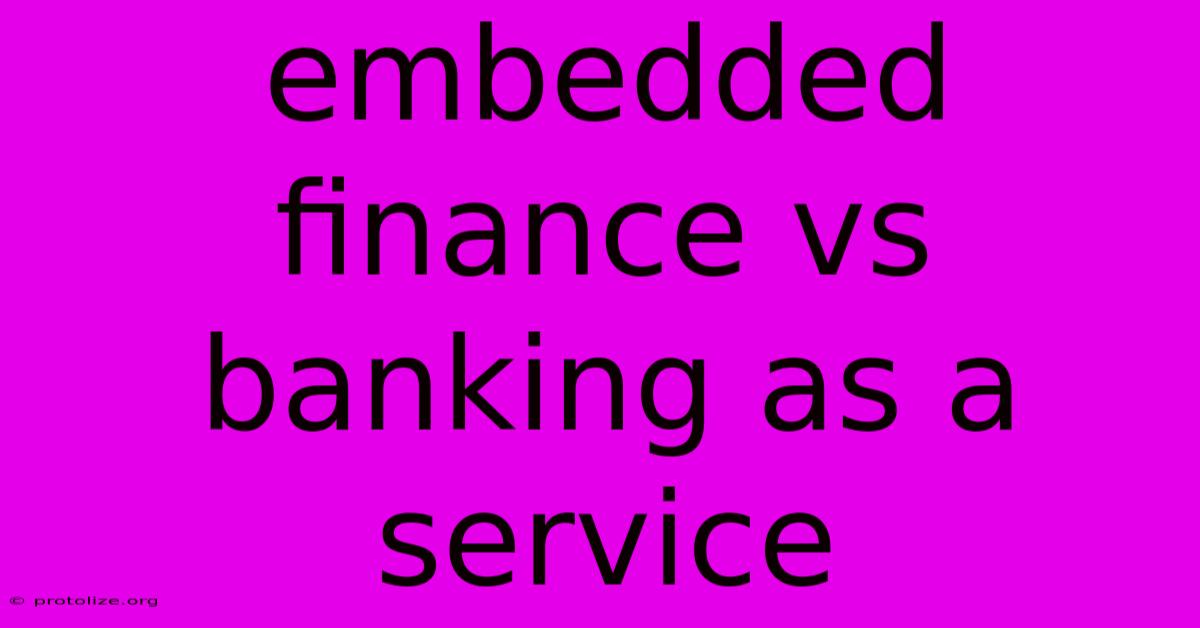Embedded Finance Vs Banking As A Service

Discover more detailed and exciting information on our website. Click the link below to start your adventure: Visit Best Website mr.cleine.com. Don't miss out!
Table of Contents
Embedded Finance vs. Banking as a Service: What's the Difference?
The financial technology (FinTech) landscape is rapidly evolving, with two prominent players vying for dominance: embedded finance and banking as a service (BaaS). While both aim to integrate financial services into non-financial applications, they differ significantly in their approach, scope, and ultimate goals. Understanding these differences is crucial for businesses looking to leverage financial technology to enhance their offerings and customer experience.
Understanding Embedded Finance
Embedded finance seamlessly integrates financial products and services directly into non-financial platforms. Imagine booking a flight and simultaneously securing travel insurance, or purchasing a piece of furniture and instantly financing it through a built-in option. This is the essence of embedded finance: offering financial services within the context of a customer's existing journey, eliminating the need for them to switch platforms or apps.
Key Characteristics of Embedded Finance:
- Customer-centric: The focus is on providing financial solutions that enhance the user experience within a familiar environment.
- Seamless integration: Financial services are invisible to the end-user; they're simply a convenient feature within the main application.
- Diverse offerings: Embedded finance can encompass a wide array of products, including payments, lending, insurance, and investment services.
- Partnerships are key: Often relies on partnerships between fintech providers and non-financial businesses to deliver the services.
Decoding Banking as a Service (BaaS)
Banking as a service (BaaS) provides a more foundational approach. It's essentially a wholesale offering where banks expose their core banking infrastructure – such as account management, payments processing, and KYC/AML compliance – via APIs to third-party developers. These developers can then build their own financial applications on top of this existing infrastructure, eliminating the need to build their own from scratch.
Key Features of BaaS:
- Infrastructure-focused: The primary focus is on providing the underlying technology and infrastructure for financial services.
- API-driven: Access to the banking services is primarily through APIs, allowing for seamless integration with other systems.
- Compliance and regulation: BaaS providers handle the heavy lifting of regulatory compliance, offering a significant advantage to developers.
- Scalability and cost-effectiveness: Leverages the existing infrastructure of the bank, reducing development time and costs.
Embedded Finance vs. BaaS: A Comparative Overview
| Feature | Embedded Finance | Banking as a Service (BaaS) |
|---|---|---|
| Focus | Customer experience & seamless integration | Providing banking infrastructure & APIs |
| Approach | Product-centric; offers specific financial services | Infrastructure-centric; provides core banking capabilities |
| Integration | Directly into non-financial platforms | Via APIs to third-party developers |
| Compliance | Often handled by embedded finance provider | Primarily handled by the BaaS provider |
| Scalability | Dependent on partnerships and infrastructure | Highly scalable due to existing bank infrastructure |
| Examples | Buying insurance during online shopping, in-app lending | Fintech building a new banking app using BaaS APIs |
The Synergistic Relationship
While distinct, embedded finance and BaaS are not mutually exclusive. In fact, they often work in synergy. Many embedded finance solutions rely on BaaS to provide the underlying banking infrastructure. A company offering embedded lending, for example, might utilize a BaaS provider to handle account management, KYC checks, and payment processing.
Choosing the Right Approach
The choice between embedded finance and BaaS depends on your specific needs and goals. If you're a non-financial business looking to enhance your customer experience by offering integrated financial services, embedded finance is likely the more suitable option. If you're a fintech company building a new financial application or platform, BaaS can provide a robust and cost-effective foundation. Ultimately, a deeper understanding of both approaches is essential for navigating the exciting and rapidly evolving world of financial technology.

Thank you for visiting our website wich cover about Embedded Finance Vs Banking As A Service. We hope the information provided has been useful to you. Feel free to contact us if you have any questions or need further assistance. See you next time and dont miss to bookmark.
Featured Posts
-
Kinsmith Finance Atlanta Ga
Dec 16, 2024
-
Certificate Course For Finance
Dec 16, 2024
-
P2p In Finance
Dec 16, 2024
-
Business Sources Of Finance
Dec 16, 2024
-
Finance Factors Online Banking
Dec 16, 2024
